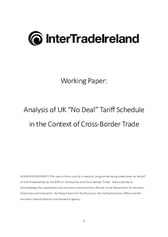Key Messages:
- The UK government published in March 2019 a temporary schedule of tariff rates to be applied for up to 12 months in the event of “no deal” exit from the EU.
- Almost all research up to now assumed a degree of symmetry in the tariffs being applied but the new schedule changes this considerably.
- Under the new tariff schedule, the UK plans to abolish tariffs entirely for a wide range of products and substantially reduce them for most others.
- It additionally announced a temporary period where the tariff being faced by exporters from Ireland to Northern Ireland would be set at zero for all goods.
- If the same temporary tariff schedule is applied to trade from Ireland to Northern Ireland as was announced for the rest of Great Britain, Irish firms would face an average tariff of 1.45%.
- This is compared to a potential increase of 17.5% if the UK had adopted the EU level of tariffs.
- In contrast, trade from Northern Ireland to Ireland with the maximum EU tariff schedule applied would increase in price by 15.8% on average.
- The majority of this tariff effect (and the resulting trade fall) for Northern Ireland would be on the Dairy sector where tariffs and increased costs of non-tariff barriers could result in close to a complete cessation of trade.
- There may be some space for exemptions under inward and outward processing rules to allow cross-border supply chains in this sector to continue but these exemptions have rarely been applied to agricultural products.
- Beef exports remain one of the few sectors where the new UK tariff schedule imposes tariffs in excess of 25% making this the most exposed of sectors exporting from Ireland.
- A reduction in the value of sterling would have the potential to offset the negative impact on
Northern Irish exporters to some extent (while making it more expensive for firms from Ireland to sell into Northern Ireland). However, as many firms are trading in both directions across the border, the gains from currency movements could be limited. - In the main, for Irish firms exporting to Northern Ireland, the trade risk would appear to shift from direct tariff costs to concern about the opening of the UK market to increased competition from lower cost countries through the tariff reductions. This also likely to be a key concern for Northern Ireland business in addition to the direct costs to their EU exports.
- Additional competitive pressures would arise from the introduction of zero rate tariff-free quotas for products such as beef and poultry as these quotas would be available to all countries.
Click here to download the full report: UK No Deal Tariff Schedule Analysis

